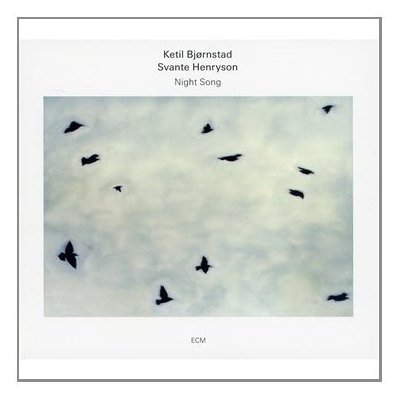
by Ian Mann
June 16, 2011
/ ALBUM
This Scandinavian piano/cello duo straddle the boundaries between chamber music and jazz.
Ketil Bjornstad and Svante Henryson
“Night Song”
(ECM 2108 270 9579)
Norwegian pianist Ketil Bjornstad’s 2010 release “Remembrance” was one of that year’s most beautiful recordings. The album saw Bjornstad leading a bassless trio featuring saxophonist Tore Brunborg and veteran ECM master drummer Jon Christensen. Brunborg subsequently went on to work with pianist John Taylor and drummer Thomas Stronen in the similarly configured group Meadow, whose Edition label début “Blissful Ignorance” looks set to be one of the key releases of 2011.
Bjornstad, also a published novelist , essayist and playwright is the Renaissance man of Norwegian culture. As a pianist and composer he is equally respected in the jazz and classical fields and this latest album, a duo recording with Swedish cellist Svante Henryson goes a long way to bridging the territory between the two genres.
Bjornstad has been with ECM since 1993 and has recorded in this format before releasing two ECM albums of piano/cello duets with David Darling, namely “The River (1996) and “Epigraphs”(1998).
Henryson made his ECM début in2001 as part of Jon Balke’s Magnetic North Orchestra on the album “Kyanos”. He has also worked with other ECM regulars including Tord Gustavsen, Marilyn Mazur, Nils Petter Molvaer and Arild Andersen. Like Bjornstad he is a highly versatile individual having worked in such diverse contexts as classical bassist with the Oslo Philharmonic and Norwegian Chamber orchestras and as bass guitarist with guitarist Yngwie Malmsteen’s rock band.
As on “Remembrance” the music on “Night Song” is structured as a suite with the album being bookended by two different versions of the title track. Of the sixteen short “movements” twelve are written by Bjornstad with a further four coming from the pen of Henryson. However such is the unified atmosphere of the piece that the handovers never become obvious.
Bjornstad’s liner notes make it clear that the seeds for this album were sown by ECM’s founder and chief producer Manfred Eicher in 2007. In the aftermath of mixing an earlier Bjornstad album, “The Light”, Eicher suggested that Bjornstad return to the piano/cello duo format the pianist had so successfully explored with David Darling. This time Eicher wished to invite Henryson to become Bjornstad’s musical partner, mindful perhaps of the pair’s previous successful collaboration at the Bath International Music Festival in 2005.
Eicher also had a high degree of input in the studio itself. In a successful attempt to create maximum intimacy between the two musicians he ensured that they sat as closely together as possible and played entirely acoustically- i.e. without the use of such studio devices as head phones and glass partitions. At times Eicher, a former orchestral bassist, actually conducted the music. Virtually every ECM release bears Eicher’s imprint but his involvement on “Night Song” seems to be even more intense than usual. From what Bjornstad states this could almost be classed as a trio recording.
The other great influence on this record is that of the classical composer Franz Schubert (1797-1828). Bjornstad has long been obsessed with Schubert’s linear melodic and harmonic patterns. He describes “Night Song” as being “conceived as a musical dialogue with Schubert and as a tribute to him”. He continues “without paraphrasing him directly many of Schubert’s musical ideas are used in this suite, not least the linear model apparent in many of the subsidiary themes of his piano sonatas, as well as the frequent shifts between major and minor keys”.
With this in mind it perhaps comes as no surprise to learn that the music sounds essentially “classical”. There are far fewer jazz elements here than there were on “Remembrance” and certainly “Night Song” is a less obviously accessible record for jazz listeners. Nevertheless the level of responsiveness between the two players is reminiscent of the best small jazz groups and it almost goes without saying that the standard of musicianship is supremely high throughout. It is perhaps significant that the album appears on ECM’s regular “jazz” imprint rather than the more classically orientated “New Series”.
In general the mood of the music is reflective, sombre even, with the rich, dark melancholy ring of Henryson’s cello the perfect foil for Bjornstad’s economic and thoughtful piano work. The cellist doesn’t just use the bow, there are several instances throughout the suite of Henryson plucking the strings in the manner of a jazz bassist, a technique that features particularly strongly on his own compositions such as “Reticence” and “Melting Ice”.
In my review of “Remembrance” I mentioned that the unified mood of the album was perhaps it’s greatest strength. Ironically here I find it something of a weakness. The running time of “Night Song” is well in excess of hour and this time round I can’t help feeling that the record would have benefited from a degree of change in mood and pace. Having said that this is essentially an album of chamber music rather than jazz and there are certainly moments here of almost painfully exquisite beauty. The velvet textures of Henryson’s cello are particularly lovely.
Nevertheless for jazz listeners who are perhaps approaching Bjornstad’s music for the first time “Remembrance” or perhaps one of the earlier band items in his back catalogue might represent a better place to start.
blog comments powered by Disqus